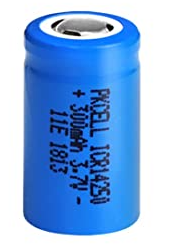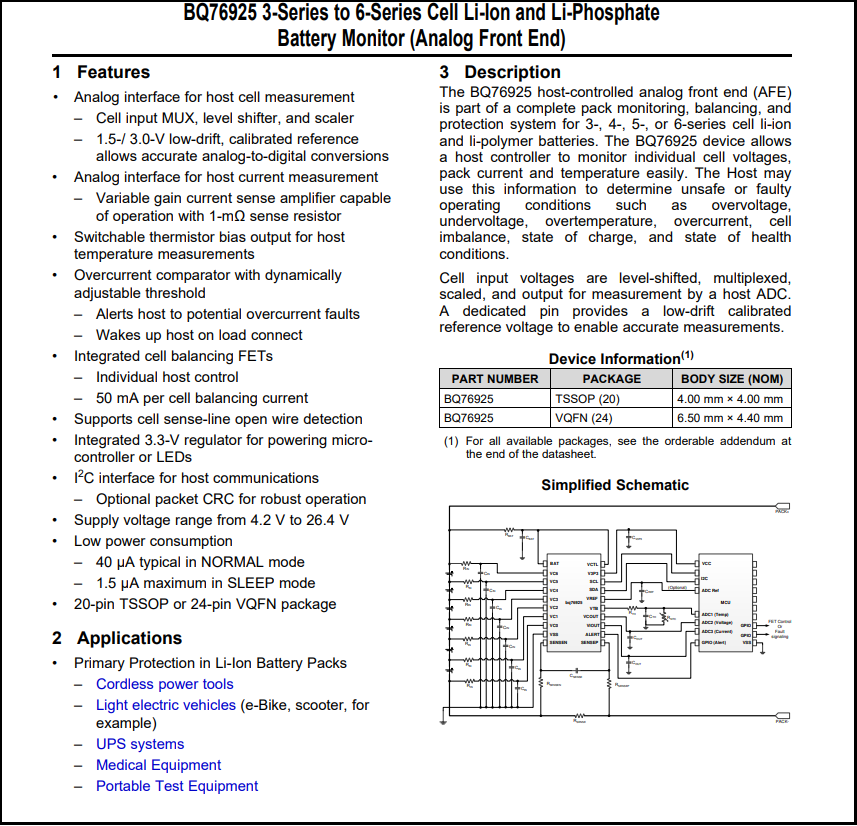Features of a Battery Monitor IC for a Battery Management System

In this article, we look at features of a battery monitor IC used for a battery management system by examining its datasheet.
Texas Instruments is one of the premier companies that manufactures ICs for battery management systems.
The battery monitor IC that we will look in this example is the bq76925 battery monitor IC.
The BQ76925 battery monitor IC is a 3-series to 6-series cell Li-Ion and Li-Phosphate battery monitor. This means that it monitors anywhere from 3 to 6 cells in series of either lithium ion or lithium iron phosphate batteries.
Below is the first page of the datasheet for this IC, which contains a description of many of the features of the IC.
You can see the entire datasheet at the following link:
BQ76925 Li Battery Monitor IC.

Many of the features we will go over in this article, so that you can get an idea of the type of features that are offered with BMS ICs.
These features may be very important for the BMS you are designing.
This is not an extensive overview of this IC, but we will go over some of it.
So under features, the first line states, Analog interface for host cell measurement.
So this IC Is capable of measuring the voltage of each cell in series of the BMS. This is done through a cell input MUX, level shifter, and scaler, which allows any of the cell voltages to be measured. A calibrated reference allows for accurate measurmement of this voltage.
The next line is, Analog interface for host current measurement
So this IC allows for current measurement of the BMS; by using a 1-mΩ sense resistor with the variable gain current sense amplifier, we can measure the current of the BMS.
The next line is, Switchable thermistor bias output for host temperature measurements
So this IC has a built-in thermistor circuit, which allows for temperature measurement.
So we can see now that this IC can measure voltage, current, and temperature.
Overcurrent comparator with dynamically adjustable threshold
So what this means is this IC can measure overcurrent conditions within the BMS and this level of overcurrent can be adjusted by the designer. We can be alerted to potential overcurrent faults. We can also wake up the host on load connect, when a load gets connected to the system.
The next line is, Integrated cell balancing FETs
So this IC provides cell balancing so that there is more even distribution of charge between all the cells in series in the system.
The next line is, Supports cell sense-line open wire detection
This means that the IC can detect when a wire is open, meaning not connected for proper sensing, such as the IC disconnecting from the battery.
The next line is, Integrated 3.3-V regulator for powering microcontroller or LEDs. This can come in handy if you are powering a microcontroller that operates off of 3V or LEDs that can operate at that level. The reason this is important is because you have to feed into this IC a supply voltage ranging from 4.2V to 26.4V. 5V is a common voltage to feed it. Now say you have a micrcocontroller that requires 3.3V for operation. Without this 3.3V regulator, you would have to place in your own regulator into the circuit. This increases costs and it can be a space restraint, as it requires space on a PCB board. Therefore, this is a nice add-on for a BMS IC.
The next line is, I2C interface for host communications. This allows the chip to communicate with other chips such as a microcontroller using the I2C communication protocol. This allows external chips to be incorporated into the BMS. In the line below, there is an optional pakcet CRC for robust operation. CRC stands for Cyclic Redundancy Checks, which checks for errors so that the system can be even more reliable.
The line, Low power consumption, is important because the chip will get its power from the circuit's battery. The less power that it consumes, the better it is for the efficiency of the battery life. This chip consumes very low current, only 40 µA in normal mode and 1.5 µA in sleep mode.
As the datasheet states, this can be used in primary protection in battery packs in applications such as cordless power tools, light electric vehicles, and other general-purpose electronic devices that are run off of low-power lithium batteries.
So, in summary, this BMS IC can provide us voltage measurement, current measurement,
temperature measurement, overcurrent detection with alerts, cell balancing, interfacing protocols
with external ICs with the I2C protocol, and many other features.
.
Related Resources
